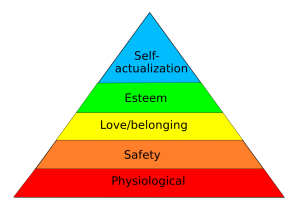In a nutshell: A well-known psychological theory of human motivation can help marketers focus their advertising messages.

In 1943, Abraham Maslow published a theory on human motivation that has been debated and used in psychology and marketing ever since.
Maslow – a psychology professor then teaching at Brooklyn College – developed a five-tier system to illustrate the different levels at which people work to satisfy needs. This “hierarchy of needs” moves from basic ones to eventual self-actualization.
The theory often is represented in a pyramid. Here are the needs in order from bottom to top.
- Physiological: Food, water, warmth and sleep
- Safety: Security, freedom from fear
- Belongingness and love: Friends, intimate relationships, becoming part of a group
- Esteem: Prestige and feelings of accomplishment
- Self-actualization: Creativity, achieving full potential.

The theory proposes that as a person meets the needs at one level, they then move on to the next.
Psychologists have used the hierarchy for decades. Before long, marketing people also began to see its value. To this day, it provides a guide for how to appeal to customers depending on where your product or service resides in the hierarchy.
Use in Marketing
Smart marketers know the most direct pathway to selling a product or service is by filling a consumer’s needs. The Maslow Hierarchy provides an easy-to-understand method for determining where a product fits into the progression of human needs.
Maslow theorized that all human decisions are made within the five levels of the hierarchy. While it’s possible to get more granular than that, marketing theory often leverages Maslow’s findings to guide strategy.
Appealing to the motivational drivers behind the needs at each level can, in theory, lead to a higher success rate in marketing. The key is understanding each level and the type of products that fit within them.
Psychological Needs
These base needs are the first people seek to satisfy. Outside of the food and bottled water industries, there’s little here for marketers to consider. Some might include restaurants in this area, but at this level people seek to address basic survival needs, not find the best New York Strip in town. Those who are seeking to satisfy needs at this level are typically not the target audience for most marketers.
Safety Needs
The insurance industry leaps to mind in this category. The entire insurance business is based on fulfilling a need for safety. This is why insurance aids often target the need to avoid the chaos and potential financial ruin of a disastrous event such as a house fire or a flood. Allstate has famously built an entire “Mayhem” campaign on the need for safety.
Safety needs also drive marketing strategy in areas such as home security and transportation. Swedish car company Volvo has made safety a primary engineering and marketing focal point for decades. The 2017 Volvo XC60 “Moments” commercial is like a mini-movie that relentlessly plays off the need for safety (involving a small child on her first day of school, no less).
Others are typically lighter on the sense of dread, but many car companies today feature campaigns about safety features and evoke the feeling of comfort and security in having them.
Belongingness and Love
This level deserves perhaps the most attention because so much of marketing falls into this area, where a large number of consumers reside. Once people have insurance, a safe car and a secure home, their attention turns to this area. They are spending disposable income.
Here, marketing moves beyond fear of potential catastrophe and more into the joy of possibilities, especially in relationships. Some of the top modern brands make consumers feel as if purchasing their product makes them part of something special. Perhaps the most famous is this spot from Coca-Cola: Buy the world a Coke, and keep it company.
More modern examples include campaigns from Apple and motorcycle maker Harley-Davidson. Both give the consumer a feeling of belonging to a special group. Fast-food giant McDonald’s also keyed in on this area of the hierarchy with their “You Deserve a Break Today” campaign, which immediately preceded today’s “I’m Loving It” campaign. The spots gave customers the feeling that McDonald’s products were something they deserved if they wanted to treat themselves.
Jewelers also focus on this area. Kay Jewelers commands marketing over the holidays, linking their products to the joy of a good relationship in the “Every Kiss Begins with Kay” campaign.
Savvy politicians also understand the need to belong. The 2016 presidential election provided a classic example with the “America” commercial from Democratic candidate Bernie Sanders. Note how in just 60 seconds, the spot moves from isolated individuals to larger and larger crowds as the song builds. The commercial perfectly demonstrates the idea of targeting emotions and a need to become part of something bigger than oneself.
Esteem Needs
Products and services that aim for consumers in this area are typically referred to as “luxury brands.” The obvious examples are in the automobile industry.
Strictly speaking, no one absolutely needs to drive an Audi, BMW, Mercedes or Lexus rather than a sturdy and reliable Honda, Ford, Chevrolet or Toyota. But effective marketing as status cars – plus, admittedly, better features and driving experience – have made these vehicles sought after by those who have fulfilled needs in the lower parts of the hierarchy. Marketing students looking to understand how to appeal to consumers need for esteem and status should spend time studying campaigns from any of these automakers.
Fashion also provides a wealth of examples, such as high-end designers Gucci, Versace, Yves Saint Laurent and Ralph Lauren. Again, there’s no inherent need to have a pair of BLK DNM jeans rather than a pair of regular Levi’s, other than a fulfillment of self-esteem.
Luxury tour companies such as Viking Cruises and Abercrombie and Kent also fulfill needs in this area, offering exclusive experiences at a premium price.
Self-Actualization
In this area, there is far less traditional marketing. People at this level are looking for ways to feel good about their achievements and activities. Examples that could fit into this category include campaigns for charities such as the United Way or UNICEF. Here, people are looking to give back and improve their world.
Retirement is another area that sometimes falls into this category. Having met all the needs of the other four levels in Maslow’s Hierarchy, some now look to leave their jobs and move on to achieving their dreams. That can include world travel or turning a hobby into a business. This also can extend to leaving a legacy for family. Some financial services launch campaigns specifically aimed at this top level.
Whatever the place in the hierarchy, the key for marketers is determining the location and building a strategy geared toward the appropriate needs. Creativity and new approaches are also a must, but Maslow’s Hierarchy provides an excellent starting point.





